初中英语语法大全——名词(共21张PPT)
文档属性
| 名称 | 初中英语语法大全——名词(共21张PPT) |  | |
| 格式 | ppt | ||
| 文件大小 | 1.3MB | ||
| 资源类型 | 教案 | ||
| 版本资源 | 通用版 | ||
| 科目 | 英语 | ||
| 更新时间 | 2022-04-09 23:20:37 | ||
图片预览


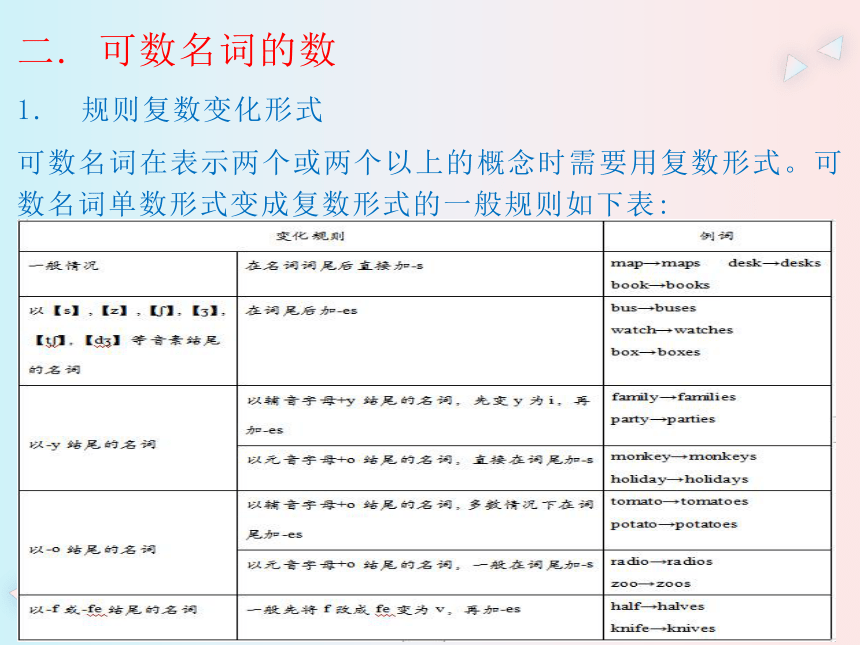
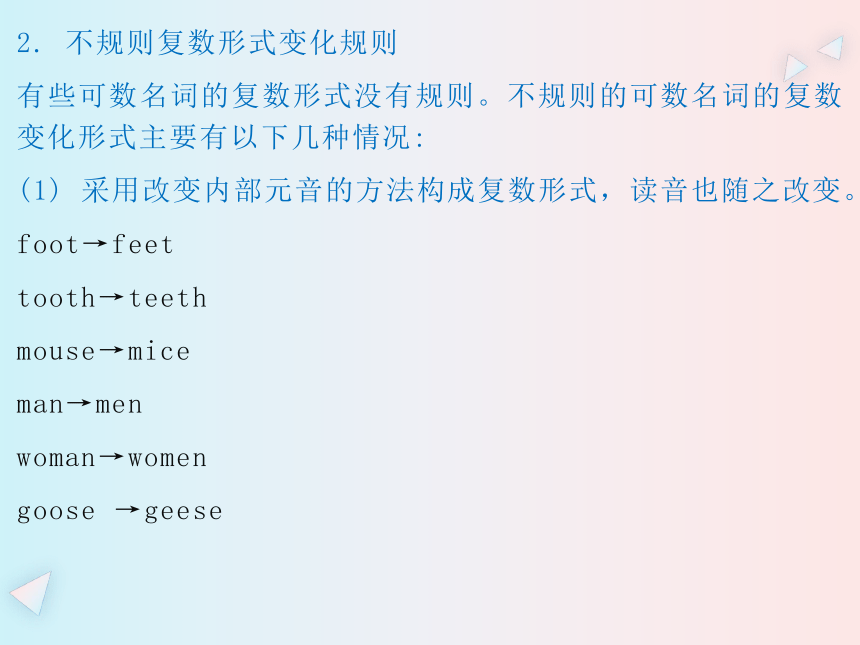
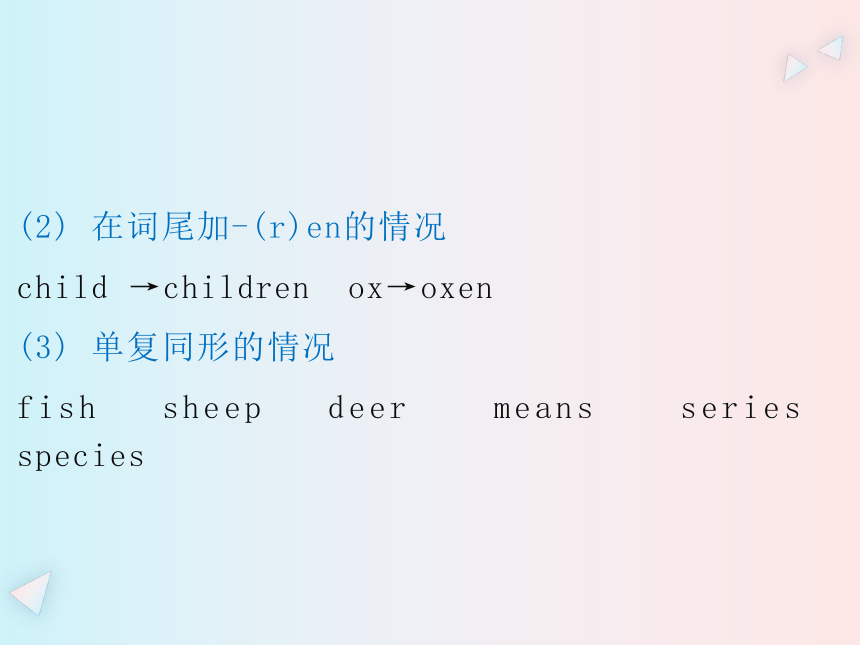
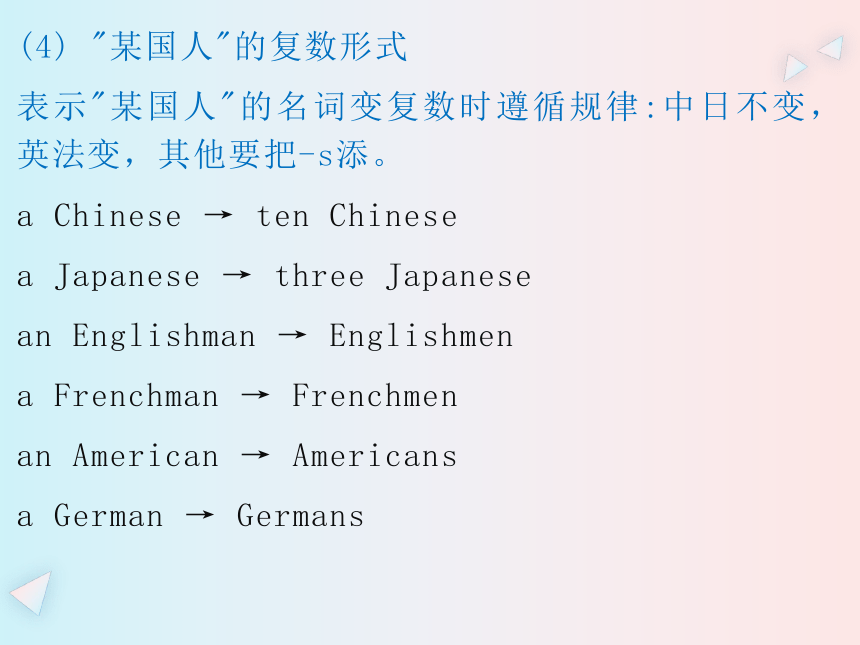
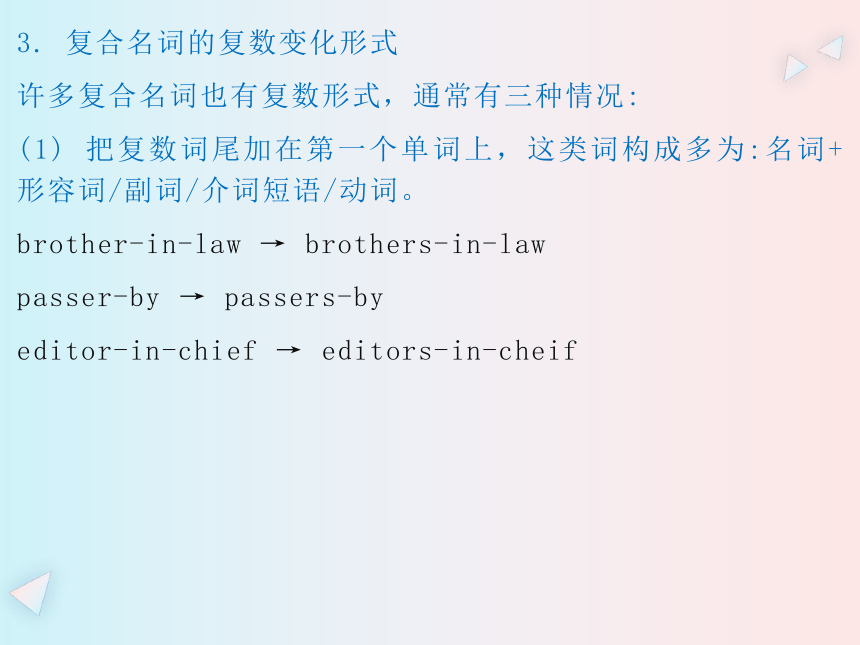


文档简介
(共21张PPT)
初中英语语法大全
名词
一. 名词的种类
一般来说,名词根据其意义,可以分为普通名词和专有名词;根据其形式,可以分为简单名词和复合名词。
1. 普通名词
普通名词是表示某一类人、事物或者抽象概念的名词。普通名词又可以分为个体名词、集体名词、物质名词和抽象名词。
2.专有名词
专有名词是指具体的人名、地名、机构名、国名、月份、节日或某一事物所特有的名称。
二. 可数名词的数
1. 规则复数变化形式
可数名词在表示两个或两个以上的概念时需要用复数形式。可数名词单数形式变成复数形式的一般规则如下表:
2. 不规则复数形式变化规则
有些可数名词的复数形式没有规则。不规则的可数名词的复数变化形式主要有以下几种情况:
(1) 采用改变内部元音的方法构成复数形式,读音也随之改变。
foot→feet
tooth→teeth
mouse→mice
man→men
woman→women
goose →geese
(2) 在词尾加-(r)en的情况
child →children ox→oxen
(3) 单复同形的情况
fish sheep deer means series species
(4) "某国人"的复数形式
表示"某国人"的名词变复数时遵循规律:中日不变,英法变,其他要把-s添。
a Chinese → ten Chinese
a Japanese → three Japanese
an Englishman → Englishmen
a Frenchman → Frenchmen
an American → Americans
a German → Germans
3. 复合名词的复数变化形式
许多复合名词也有复数形式,通常有三种情况:
(1) 把复数词尾加在第一个单词上,这类词构成多为:名词+形容词/副词/介词短语/动词。
brother-in-law → brothers-in-law
passer-by → passers-by
editor-in-chief → editors-in-cheif
(2) 在复数词尾加在最后一个单词上,这类复合名词的构成多为: 名词/动名词/形容词/副词+名词或复合名词中无主体名词。
grown-up → grown-ups 成年人
go-between → go-betweens 中间人
hang-up → hang-ups 障碍
(3) 构成复合名词的两个词都要变成复数,这类词中多包括有man,woman作为第一部分的复合名词。
man doctor → men doctors
woman drivers →women drivers
man servant → men servants
3. 复合名词的复数变化形式
许多复合名词也有复数形式,通常有三种情况:
(1) 把复数词尾加在第一个单词上,这类词构成多为:名词+形容词/副词/介词短语/动词。
brother-in-law → brothers-in-law
passer-by → passers-by
editor-in-chief → editors-in-cheif
三. 不可数名词
1. 不可数名词的量化表达
eg: He had much bread this morning.
eg: Please give me a piece of paper.
eg: There are There bottles of milk on the table.
四. 名词的格
1. -'s 所有格的构成
(2)-'s所有格的用法
A. 大多表示有生命的名词的所有关系
eg: John's clothes are made by hand in Italy.
eg: There are some student's books on the desk.
B. 表示两人或多人共有时,只变化最后一个名词的词尾; 如果为各自所有,各个名词的词尾都要变化。
eg: He is my father and mother's friend.
eg: Frank's and Jane's cars are both Fiat.
C. 表示时间、距离、度量衡、价值、自然现象、国家、城镇等无生命事物的名词,也可用-'s所有格。
eg: The boss gave me two days' holiday because of my illness.
eg: Today's newspaper is on your table.
eg: China's weather is quite different from south to north.
D. 表示诊所、店铺、医院、学校、住宅或公共建筑时,-'s所有格后常常不出现其所修饰的名词。
eg: Little Tom is being scolded at the teacher's office.
eg: I often buy meat at the butcher's shop.
E. 有时为了避免重复,可单独使用-'s所有格,其作用在句中相当于名词。
eg: Our room is bigger than Mike's.
eg: Today's temperature is higher than yesterday's.
F. 含有else的-'s所有格中,else用于不定代词、疑问词之后,其所有格形式用else's形式。
eg: The e-dictionary is not mine. It's someone else's.
eg: Who else's bag is this
2.of所有格的构成和用法
“名词+of+名词”构成of所有格。一般来说,无生命的名词常用of所有格形式。
eg: The leaves of most trees will fall in autumn.
eg: There is something wrong with the engine of the car.
3.双重所有格的构成和用法
“of+-’s所有格/名词性物主代词”构成双重所有格,表示整体中的一个或者一部分。其用法如下:
(1)双重所有格中带有-’s所有格的名词必须是一个明确的限定的指人的名词。
eg: David is a friend of my father’s.
eg: She is a teacher of my son’s.
(2)表示部分概念时,of前面的名词必须为不确指的名词,其前常用不定冠词、数词、不定代词或指示代词。
eg: Some friends of my sister’s will join us in the game.
eg: Many relatives of hers have been abroad.
四. 名词的数量修饰语
A.只修饰可数名词
B.只修饰不可数名词
C.既修饰可数名词又修饰不可数名词
初中英语语法大全
名词
一. 名词的种类
一般来说,名词根据其意义,可以分为普通名词和专有名词;根据其形式,可以分为简单名词和复合名词。
1. 普通名词
普通名词是表示某一类人、事物或者抽象概念的名词。普通名词又可以分为个体名词、集体名词、物质名词和抽象名词。
2.专有名词
专有名词是指具体的人名、地名、机构名、国名、月份、节日或某一事物所特有的名称。
二. 可数名词的数
1. 规则复数变化形式
可数名词在表示两个或两个以上的概念时需要用复数形式。可数名词单数形式变成复数形式的一般规则如下表:
2. 不规则复数形式变化规则
有些可数名词的复数形式没有规则。不规则的可数名词的复数变化形式主要有以下几种情况:
(1) 采用改变内部元音的方法构成复数形式,读音也随之改变。
foot→feet
tooth→teeth
mouse→mice
man→men
woman→women
goose →geese
(2) 在词尾加-(r)en的情况
child →children ox→oxen
(3) 单复同形的情况
fish sheep deer means series species
(4) "某国人"的复数形式
表示"某国人"的名词变复数时遵循规律:中日不变,英法变,其他要把-s添。
a Chinese → ten Chinese
a Japanese → three Japanese
an Englishman → Englishmen
a Frenchman → Frenchmen
an American → Americans
a German → Germans
3. 复合名词的复数变化形式
许多复合名词也有复数形式,通常有三种情况:
(1) 把复数词尾加在第一个单词上,这类词构成多为:名词+形容词/副词/介词短语/动词。
brother-in-law → brothers-in-law
passer-by → passers-by
editor-in-chief → editors-in-cheif
(2) 在复数词尾加在最后一个单词上,这类复合名词的构成多为: 名词/动名词/形容词/副词+名词或复合名词中无主体名词。
grown-up → grown-ups 成年人
go-between → go-betweens 中间人
hang-up → hang-ups 障碍
(3) 构成复合名词的两个词都要变成复数,这类词中多包括有man,woman作为第一部分的复合名词。
man doctor → men doctors
woman drivers →women drivers
man servant → men servants
3. 复合名词的复数变化形式
许多复合名词也有复数形式,通常有三种情况:
(1) 把复数词尾加在第一个单词上,这类词构成多为:名词+形容词/副词/介词短语/动词。
brother-in-law → brothers-in-law
passer-by → passers-by
editor-in-chief → editors-in-cheif
三. 不可数名词
1. 不可数名词的量化表达
eg: He had much bread this morning.
eg: Please give me a piece of paper.
eg: There are There bottles of milk on the table.
四. 名词的格
1. -'s 所有格的构成
(2)-'s所有格的用法
A. 大多表示有生命的名词的所有关系
eg: John's clothes are made by hand in Italy.
eg: There are some student's books on the desk.
B. 表示两人或多人共有时,只变化最后一个名词的词尾; 如果为各自所有,各个名词的词尾都要变化。
eg: He is my father and mother's friend.
eg: Frank's and Jane's cars are both Fiat.
C. 表示时间、距离、度量衡、价值、自然现象、国家、城镇等无生命事物的名词,也可用-'s所有格。
eg: The boss gave me two days' holiday because of my illness.
eg: Today's newspaper is on your table.
eg: China's weather is quite different from south to north.
D. 表示诊所、店铺、医院、学校、住宅或公共建筑时,-'s所有格后常常不出现其所修饰的名词。
eg: Little Tom is being scolded at the teacher's office.
eg: I often buy meat at the butcher's shop.
E. 有时为了避免重复,可单独使用-'s所有格,其作用在句中相当于名词。
eg: Our room is bigger than Mike's.
eg: Today's temperature is higher than yesterday's.
F. 含有else的-'s所有格中,else用于不定代词、疑问词之后,其所有格形式用else's形式。
eg: The e-dictionary is not mine. It's someone else's.
eg: Who else's bag is this
2.of所有格的构成和用法
“名词+of+名词”构成of所有格。一般来说,无生命的名词常用of所有格形式。
eg: The leaves of most trees will fall in autumn.
eg: There is something wrong with the engine of the car.
3.双重所有格的构成和用法
“of+-’s所有格/名词性物主代词”构成双重所有格,表示整体中的一个或者一部分。其用法如下:
(1)双重所有格中带有-’s所有格的名词必须是一个明确的限定的指人的名词。
eg: David is a friend of my father’s.
eg: She is a teacher of my son’s.
(2)表示部分概念时,of前面的名词必须为不确指的名词,其前常用不定冠词、数词、不定代词或指示代词。
eg: Some friends of my sister’s will join us in the game.
eg: Many relatives of hers have been abroad.
四. 名词的数量修饰语
A.只修饰可数名词
B.只修饰不可数名词
C.既修饰可数名词又修饰不可数名词
同课章节目录
- 词法
- 名词
- 动词和动词短语
- 动词语态
- 动词时态
- 助动词和情态动词
- 非谓语动词
- 冠词
- 代词
- 数词和量词
- 形容词副词及其比较等级
- 介词和介词短语
- 连词和感叹词
- 构词法
- 相似、相近词比较
- 句法
- 陈述句
- 一般疑问句和否定疑问句
- 特殊疑问句及选择疑问句
- 反意疑问句
- 存在句(There be句型)
- 宾语从句
- 定语从句
- 状语从句
- 主谓一致问题
- 简单句
- 并列句
- 复合句
- 主谓一致
- 主、表语从句
- 名词性从句
- 直接引语和间接引语
- 虚拟语气
- 感叹句
- 强调句
- 倒装句
- 祈使句
- 句子的成分
- 句子的分类
- 题型专区
- 单项选择部分
- 易错题
- 完形填空
- 阅读理解
- 词汇练习
- 听说训练
- 句型转换
- 补全对话
- 短文改错
- 翻译
- 书面表达
- 任务型阅读
- 语法填空
- 其他资料
